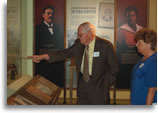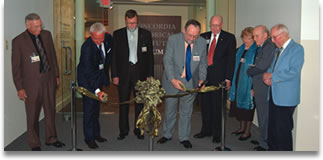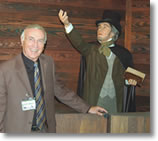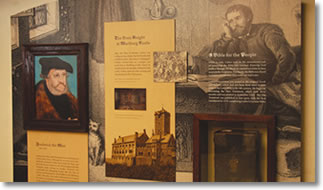The pure Gospel of Christ,
Rediscovered by Luther and his fellow confessors,
Carried across oceans, cultures, and generations
By emigrants, missionaries, and ministers,
Today touching the farthest reaches of the earth.
May it touch your heart also.
Amen.
by Roland Lovstad
Offering a succinct description of content and purpose, this message greets visitors to the new Concordia Historical Institute Museum at the LCMS International Center in St. Louis.
The museum is a celebration of the diverse gifts the Lord gives and employs to build the part of His church called The Lutheran Church—Missouri Synod, according to Rev. Marvin Huggins, interim director of Concordia Historical Institute (CHI). He says the people featured in the exhibits are examples of how God has used their diverse gifts for conveying the Gospel of salvation in Jesus Christ.
In his chapel message before the first viewing by LCMS employees, Huggins noted the “spiritual gifts” message of 1 Cor. 12:4–31. That passage is one of two cited by the founders in 1847—and still a part of the Constitution today—as a reason for forming The Lutheran Church—Missouri Synod: “Our Lord’s will that the diversity of gifts should be for the common profit.” (The other passage is Acts 15:1–31: “the example of the apostolic church.”)
“The museum presents those gifts, shows how those gifts have been used, and how God’s purpose has been accomplished through them,” Huggins says. “They serve as inspiration and guidance as we use our diverse gifts in continuing to carry on the mission and serve that common purpose.”
Dedicated July 26, the museum, on the second floor of the International Center, is now open to the public.
|
|
Dr. William R. Diekelman, second from left, LCMS first vice president, and Rev. Marvin Huggins, center, CHI interim director, cut the ribbon at the opening of the new CHI museum at the LCMS International Center. Also, from left to right: Dr. James Kalthoff, former president of the LCMS Missouri District and vice president, CHI Board of Governors; Dr. Bruce Kintz, president and CEO, Concordia Publishing House; Larry Lumpe, president, CHI Board of Governors; Phyllis and Richard Dussenberg; and Werner Krause.Photo: Frank Kohn and Jessica Paul/LCMS Board for Communication Services |
Beginning with Martin Luther and the Reformation, the museum features five sections tracing the origin and development of the LCMS. A section on German immigration to America reflects early efforts to send missionaries and pastors from Germany, especially to immigrants in the Midwest. Another section focuses on the formation and growth of the Synod in the mid–19th century under the leadership of Dr. C.F.W. Walther and others. A fourth area deals with mission efforts, first among Native Americans and extending to African Americans and to foreign mission fields. A fifth section emphasizes 20th– and 21st–century growth in education, use of media, human care, and auxiliaries such as the Lutheran Laymen’s League and Lutheran Women’s Missionary League.
|
|
|
Dr. James KalthoffPhoto: Frank Kohn and Jessica Paul/LCMS Board for Communication Services |
More than narrative, the museum seeks to give a flavor of the periods of history, with a reproduction of the Castle Church door where Luther posted his 95 theses, supplemented with 16th–century books written by the Reformer. In another section, a life-size figure, speaking in a German accent, delivers a Gospel message against the backdrop of a wharf and steamer trunks.
Pages from journals, letters, and hymnody reflect 19th– century growth that included orphanages, colleges, and publications. Visitors can see the carriage and piano used by Walther, who became the first LCMS president. Another exhibit includes a life-size figure of Dr. Walter A. Maier in his KFUO studio with audio excerpts from his “Lutheran Hour” sermons. A world map allows visitors to trace mission expansion, and a video describes the philosophy of outreach through missions and human care.
The result of nearly five years of planning, including a year of construction, the museum is “an excellent display of the historical materials,” says Larry Lumpe, president of the CHI Board of Governors. “I feel very strongly that the history is important, that we know about the people who came to this country and how they viewed the church as an opportunity to stay true to God’s Word.”
 Lumpe expressed appreciation to donors whose gifts funded the design and construction of the museum.
Lumpe expressed appreciation to donors whose gifts funded the design and construction of the museum.
Founded in 1927, CHI has amassed some 2.5 million documents pertaining to Lutheran history in the United States. Housed in its building on the Concordia Seminary campus in St. Louis, the archives include some 7,500 arti-facts. The new museum will allow the institute to expand its archival space and to continue hosting thematic exhibits at its seminary facility.
“Our staff has done an excellent job of getting into the archives and finding things—the discovery in some cases— of items that were there,” Lumpe says. “Now is the time to show them. The Lord has given us that time.”
While CHI gathers materials and assists researchers, Huggins observes that the institute wants to be proactive in presenting the Synod’s history and heritage. “We look to the past to praise God for what He has done through His Gospel, but also to move on with our mission today in the same light,” he says.
“It has always been my dream that we can use this for curricula for our Lutheran schools,” Lumpe says. The institute will explore curricula possibilities with Concordia Publishing House and the Schools Department of LCMS District and Congregational Services, including ways to make educational resources available via the Internet.
|
|
Part of the ‘Luther and Reformation’ display at the CHI museum |
Hours at the museum are 8:15 to 3:30 weekdays, except holidays. Admission is free, and while volunteers will greet visitors, tours are self-guided. Groups are welcome and are encouraged to inform CHI of their plans by calling 314-505-7900. CHI also operates the Saxon Lutheran Memorial in Frohna, Mo., which includes historic buildings and exhibits reflecting the life of mid–19th century Saxon immigration from Germany.








